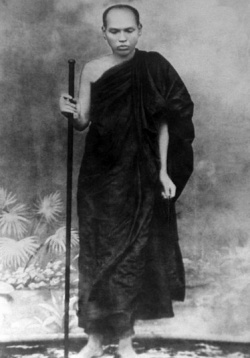Ledi Sayadaw
Ledi Sayadaw U Ñanadhaja , pronounced: [lɛ̀dì sʰəjàdɔ̀ ʔú ɲàna̰dəza̰]; 1 December 1846 – 27 June 1923) was an influential Theravada Buddhist monk. He was recognized from a young age as being developed in both the theory and practice of Buddhism and so was revered as being both scholarly and saintly. He wrote many books on Dhamma in Burmese and these were accessible even to a serious lay person, hence he was responsible for spreading Dhamma to all levels of society and reviving the traditional practice of vipassana meditation, making it more available for renunciates and lay people alike.
He learned the technique of Vipassana still being taught in the caves of the Sagaing Hills; and after mastering the technique, he began to teach it to others. His vihara (monastery) was in Ledi village near the town of Monywa. There he meditated most of the time and taught the other bhikkhus. His leading disciple was a farmer Thet Gyi and so began a chain of lay teachers that continues to the present, the most prominent being Ba Khin and his disciple Mother Sayamagyi Daw Mya Thwin. Previously only the monks were taught vipassana.
In 1885, he wrote the Nwa-myitta-sa , a poetic prose letter that argued that Burmese Buddhists should not kill cattle and eat beef, since Burmese farmers depended on them as beasts of burden to maintain their livelihoods, that the marketing of beef for human consumption threatened the extinction of buffalo and cattle and that the practice and was ecologically unsound. He subsequently led successful beef boycotts during the colonial era, despite the presence of beef eating among locals and influenced a generation of Burmese nationalists in adopting this stance.
At other times he travelled throughout Myanmar. Because of his knowledge of pariyatti (theory), he was able to write many books on Dhamma in both Pali and Burmese languages such as, Paramattha-dipani (Manual of Ultimate Truth), Nirutta-dipani, a book on Pali grammar and The Manuals of Dhamma. At the same time he kept alive the pure tradition of patipatti (practice) by teaching the technique of Vipassana to a few people.
Ledi Sayadaw was perhaps the most outstanding Buddhist figure of his age. He was instrumental in reviving the traditional practice of Vipassana, making it more available for renunciates and lay people alike. In addition to this most important aspect of his teaching, his concise, clear and extensive scholarly work served to clarify the experiential aspect of Dhamma. Many of his works are still available, including in English through the Buddhist Publication Society.
Writings
Manual of Insight (Vipassanā Dīpanī)
Manual of Conditional Relations (Patthanuddesa Dīpanī)
Manual of Right Views (Vipassanā Dīpanī)
Manual of the Four Noble Truths (Catusacca Dīpanī)
Manual of the Factors of Enlightenment (Bodhipakkhiya Dīpanī)
Manual of the Constituents of the Path (Magganga Dīpanī)
Five Kinds of Light (Alin Kyan
5 Questions on Kamma; Anattanisamsā
